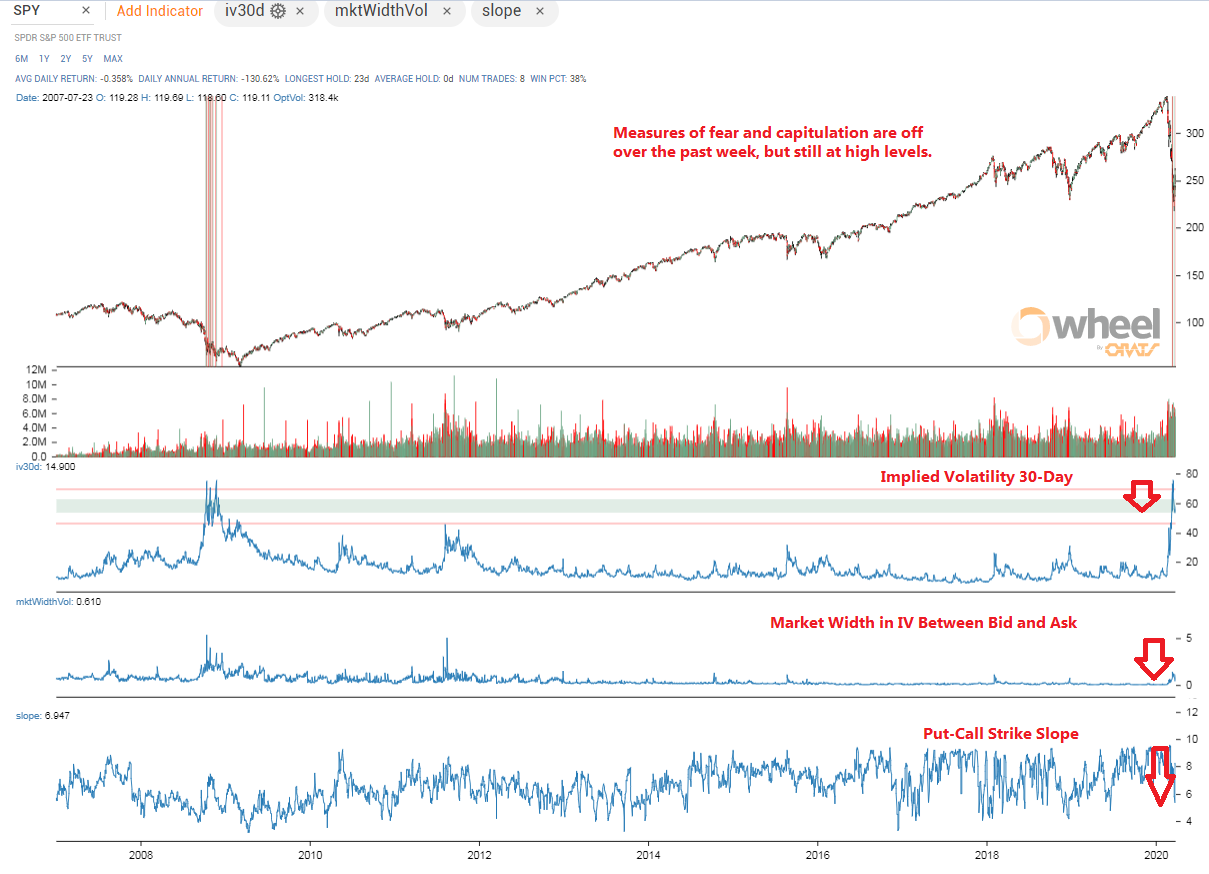Market Events
Friday, March 27th 2020
Reuters Article On Fear Measures: Volatility, Skew and Bid-Ask Spreads with Matt Amberson
Fear measures from the options markets, implied volatility, bid-ask spreads, and put-call strike slope hit a high last week and are coming off but are still elevated.
Summary
The fear measures from the options markets, including implied volatility, bid-ask spreads, and put-call strike slope, hit a high last week and are coming off but still elevated. Realized volatility on the S&P 500 was at 97.4% on Friday, according to data from options analytics provider Trade Alert. Other measures, however, signal that some investors believe the selling may have already peaked.
Read the article here: https://www.reuters.com/article/us-health-coronavirus-vix/elevated-wall-street-fear-gauge-shows-doubts-about-stock-market-rebound-idUSKBN21E2YC
As we showed in our blog back in mid-March https://blog.orats.com/extreme-fear.-is-this-the-bottom-charting-the-virus-with-options-data, measures of panic and capitulation hit a crescendo. These data points are backing off but not too quickly.

It may take months for the VIX to ease back to its usual levels, said Matt Amberson, principal at ORATS.
Realized volatility on the S&P 500 .SPX - a measure of actual moves on the index over the past 30 days - was at 97.4% on Friday, according to data from options analytics provider Trade Alert. By comparison, the VIX does not seem so high.
“Vol is very fair given the kind of moves that we’re having,” said Henry Schwartz, founder of Trade Alert.
Other measures, however, signal that some investors believe the selling may have already peaked.
For options on the SPDR S&P 500 ETF Trust (SPY.P), implied volatility, bid-ask spreads and skew have all drifted lower after surpassing 2008 levels last week, Amberson said.
Implied volatility reflects investor expectations for market gyrations over the next month. The bid-ask spread is the gap between what sellers say they want to receive for securities and what buyers say they will pay. Skew measures the demand for puts, used to protect against downward moves, in comparison to calls, used to position for upside.
Disclaimer:
The opinions and ideas presented herein are for informational and educational purposes only and should not be construed to represent trading or investment advice tailored to your investment objectives. You should not rely solely on any content herein and we strongly encourage you to discuss any trades or investments with your broker or investment adviser, prior to execution. None of the information contained herein constitutes a recommendation that any particular security, portfolio, transaction, or investment strategy is suitable for any specific person. Option trading and investing involves risk and is not suitable for all investors.
All opinions are based upon information and systems considered reliable, but we do not warrant the completeness or accuracy, and such information should not be relied upon as such. We are under no obligation to update or correct any information herein. All statements and opinions are subject to change without notice.
Past performance is not indicative of future results. We do not, will not and cannot guarantee any specific outcome or profit. All traders and investors must be aware of the real risk of loss in following any strategy or investment discussed herein.
Owners, employees, directors, shareholders, officers, agents or representatives of ORATS may have interests or positions in securities of any company profiled herein. Specifically, such individuals or entities may buy or sell positions, and may or may not follow the information provided herein. Some or all of the positions may have been acquired prior to the publication of such information, and such positions may increase or decrease at any time. Any opinions expressed and/or information are statements of judgment as of the date of publication only.
Day trading, short term trading, options trading, and futures trading are extremely risky undertakings. They generally are not appropriate for someone with limited capital, little or no trading experience, and/ or a low tolerance for risk. Never execute a trade unless you can afford to and are prepared to lose your entire investment. In addition, certain trades may result in a loss greater than your entire investment. Always perform your own due diligence and, as appropriate, make informed decisions with the help of a licensed financial professional.
Commissions, fees and other costs associated with investing or trading may vary from broker to broker. All investors and traders are advised to speak with their stock broker or investment adviser about these costs. Be aware that certain trades that may be profitable for some may not be profitable for others, after taking into account these costs. In certain markets, investors and traders may not always be able to buy or sell a position at the price discussed, and consequently not be able to take advantage of certain trades discussed herein.
Be sure to read the OCCs Characteristics and Risks of Standardized Options to learn more about options trading.
Related Posts



